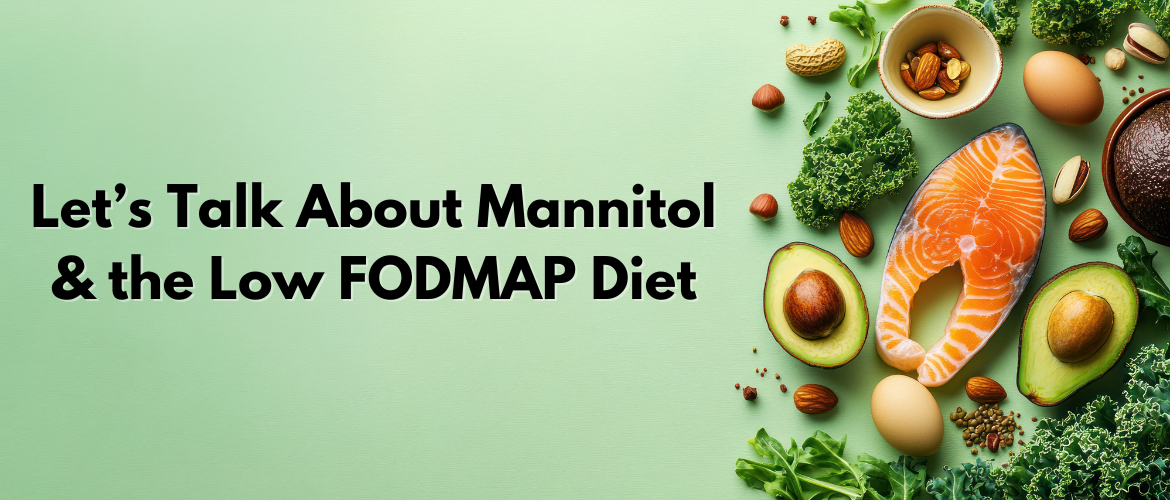No products in the cart.
Let’s Talk About Mannitol & the Low FODMAP Diet

Introduction
The Low FODMAP Diet has gained popularity as an effective strategy for managing irritable bowel syndrome (IBS) and other digestive disorders. It focuses on reducing foods that contain fermentable short-chain carbohydrates that can trigger bloating, gas, and digestive discomfort. One of the compounds that often comes up in conversations about gut health and digestion is mannitol, a sugar alcohol used in food products, medications, and medical treatments.
While mannitol is commonly found in sugar-free foods, some medications, and even medical procedures, its effect on gut health varies among individuals. As part of the FODMAP classification, mannitol falls under the category of polyols, which can cause issues for those sensitive to high-FODMAP foods.
In this blog, we’ll explore:
- What mannitol is and how it affects digestion
- Its relationship with the Low FODMAP Diet
- Food sources that contain mannitol
- Who should avoid mannitol and alternatives for gut-friendly choices
- Practical tips on maintaining a low FODMAP lifestyle
What Is Mannitol?
Mannitol is a type of polyol, which means it’s a sugar alcohol that provides sweetness without being fully absorbed by the body. Unlike regular sugar, which is rapidly digested and used for energy, mannitol travels through the digestive tract without being completely metabolized, making it a low-calorie sweetener.
Because of its osmotic properties, mannitol pulls water into the intestines, which can lead to bloating, diarrhea, and abdominal discomfort in sensitive individuals. This effect is particularly noticeable in people following the Low FODMAP Diet, which aims to reduce fermentable carbohydrates that cause digestive distress.
Uses of Mannitol
Mannitol serves multiple purposes in food, medicine, and medical treatments, including:
- Food Industry: Used as a sugar substitute in sugar-free candies, gum, and baked goods.
- Pharmaceuticals: Added to medicines and chewable tablets to improve flavor and texture.
- Medical Treatments: Used as an osmotic diuretic to reduce brain swelling and lower intraocular pressure in critical conditions.
Despite its benefits, mannitol’s FODMAP classification means it can lead to digestive discomfort in individuals sensitive to polyols.
Mannitol and the Low FODMAP Diet
The Low FODMAP Diet, developed by researchers at Monash University, is designed to help individuals with IBS and functional gut disorders reduce symptom-triggering foods. The diet eliminates high-FODMAP foods for a period before slowly reintroducing them to determine tolerance levels.
Mannitol as a High FODMAP Ingredient
Mannitol is classified as high FODMAP, meaning it has the potential to trigger gut discomfort. Here’s why:
- Incomplete Absorption: Since mannitol isn’t fully digested, it remains in the intestines and can cause fermentation by gut bacteria, leading to bloating.
- Osmotic Effect: Mannitol attracts water into the intestines, increasing diarrhea risk, especially for individuals with IBS or sensitive digestion.
- Gas Production: Polyols like mannitol ferment in the colon, leading to gas buildup and abdominal pain.
Common Symptoms After Consuming Mannitol
Individuals sensitive to mannitol may experience:
✔ Bloating
✔ Abdominal cramping
✔ Diarrhea
✔ Gas and flatulence
✔ Changes in stool consistency
For these reasons, mannitol-containing foods are generally restricted on the Low FODMAP Diet, particularly during the elimination phase.
Foods That Contain Mannitol
If you’re following a Low FODMAP Diet, being aware of where mannitol is found can help prevent digestive discomfort. Mannitol is naturally present in certain vegetables and artificial sweeteners, and it’s also commonly added to processed foods.
High-Mannitol Foods to Limit or Avoid
✅ Sugar-Free Products:
- Sugar-free chewing gum
- Sugar-free candies and mints
- Diet sodas and flavored waters containing polyols
✅ Vegetables Naturally High in Mannitol:
- Cauliflower
- Mushrooms
- Snow peas
- Celery
✅ Medications Containing Mannitol:
- Some chewable tablets and cough syrups
- Certain IV solutions for brain swelling treatments
Since mannitol can exacerbate digestive symptoms, individuals following a Low FODMAP Diet should check ingredient labels carefully, particularly on processed foods and supplements.
Who Should Avoid Mannitol?
Mannitol is problematic for certain groups of people, particularly those with digestive conditions or specific dietary needs.
1. Individuals with IBS or Gut Sensitivities
Those with IBS or functional bowel disorders often react poorly to mannitol, leading to symptoms like diarrhea, gas, bloating, and cramps. For these individuals, sticking to Low FODMAP alternatives is essential.
2. Those with Sugar Alcohol Sensitivities
Some individuals are naturally sensitive to sugar alcohols, including mannitol, sorbitol, and xylitol. If consuming sugar-free products frequently leads to digestive discomfort, avoiding polyol-containing foods can help.
3. People Managing Blood Sugar Levels
While mannitol is considered low-glycemic, excessive intake may still cause blood sugar fluctuations, making it important for diabetics to monitor their consumption.
Low FODMAP Alternatives to Mannitol
For those following a Low FODMAP Diet, there are plenty of gut-friendly alternatives that offer sweetness without digestive distress. Here are some great options:
1. Natural Low-FODMAP Sweeteners
✔ Maple syrup
✔ Rice syrup
✔ Sucrose (table sugar)
✔ Glucose-based sweeteners
2. Low-FODMAP Vegetables
✔ Carrots
✔ Zucchini
✔ Spinach
✔ Bell peppers
3. Low-FODMAP Beverages
✔ Water and herbal teas
✔ Lactose-free milk
✔ Coconut milk (small amounts)
Choosing Low FODMAP-friendly ingredients allows individuals with IBS and digestive disorders to enjoy meals without discomfort.
Practical Tips for a Low FODMAP Lifestyle
Following a Low FODMAP Diet can be challenging, but with the right strategies, it becomes easier to avoid trigger foods, including mannitol.
✔ Read Labels Carefully: Look for hidden polyols in sugar-free products and processed foods.
✔ Choose Natural Sweeteners: Opt for maple syrup or sucrose instead of artificial sweeteners.
✔ Experiment with Reintroductions: After the elimination phase, test small amounts of mannitol-containing foods to assess tolerance.
✔ Stay Hydrated: Since mannitol pulls water into the intestines, drinking enough fluids can balance hydration levels.
✔ Work with a Dietitian: A nutrition expert can help customize a Low FODMAP plan for better digestive health.
Conclusion
Mannitol plays a significant role in both medical treatments and food production, but it can be problematic for individuals following a Low FODMAP Diet. As a high-FODMAP ingredient, it has the potential to trigger bloating, gas, and digestive discomfort, making awareness and moderation essential for those with IBS and food sensitivities.
By understanding where mannitol is found, how it affects digestion, and which Low FODMAP alternatives can be used instead, individuals can make informed dietary choices that support gut health and overall wellness.
Start your wellness journey today — Visit Unike Nutra Now
Follow us
Facebook – https://www.facebook.com/profile.php?id=61567462823245
Instagram – https://www.instagram.com/unikenutra/
Twitter – https://x.com/Unikenutra
LinkedIn: https://www.linkedin.com/company/unike-nutra/
Amazon: https://www.amazon.com/stores/UnikeNutra/
Buy Now:

